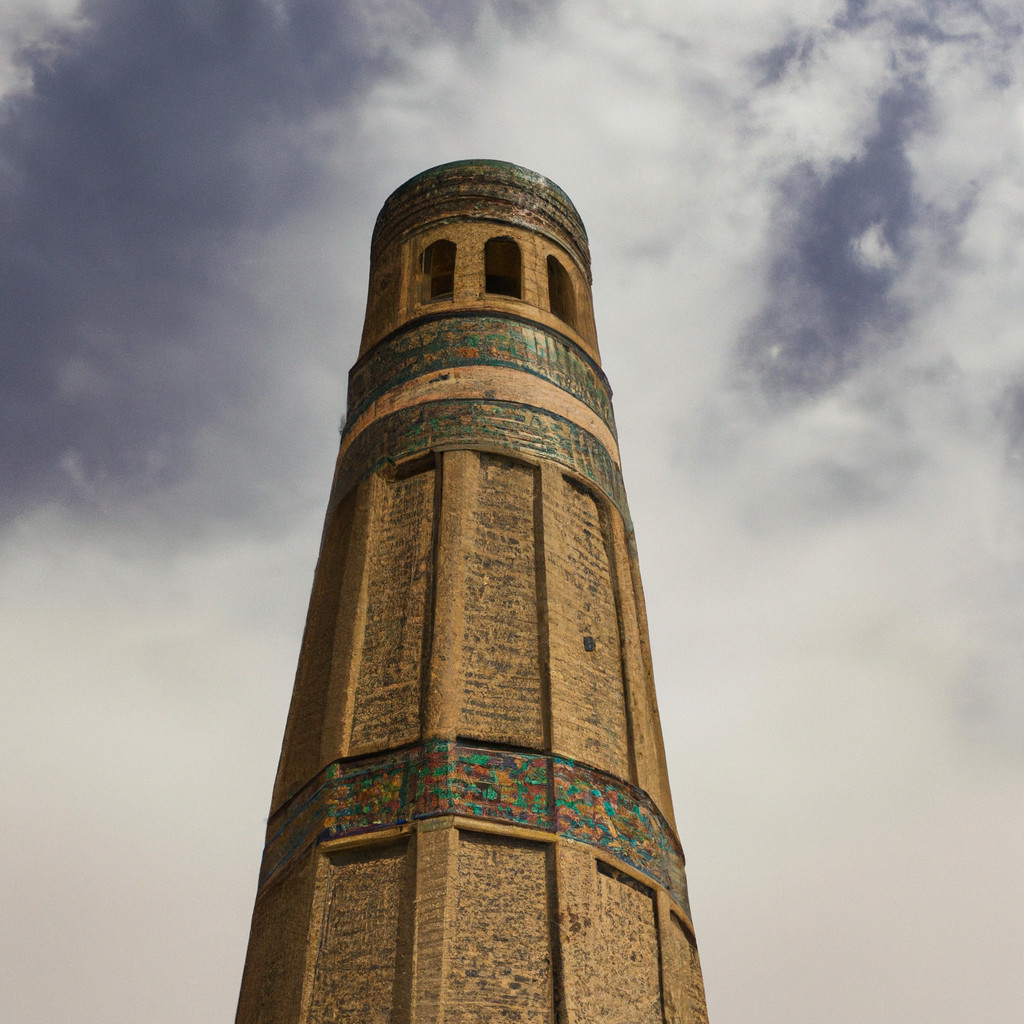Bahram Shah Minaret in Ghazni City, is one of many fascinating sites that both foreign visitors and local tourists can explore while they visit Afghanistan and exploring the Ghazni Province. This historical monument is an architectural marvel that proudly stands as a symbol of ancient Afghanistan. Overlooking the splendor of Ghazni City, the minaret—also known as the Tower of Victory—exudes a sense of intrigue and ageless beauty. It personifies the rich cultural and historical tapestry of Ghazni Province, offering a captivating trip down history lanes that many regard as an enriching experience.
Bahram Shah Minaret Most Important Events
- Construction under Bahram Shah: Arguably the most impactful event in the history of Bahram Shah Minaret was its construction itself in the early 12th century under the reign of the Ghaznavid King, Bahram Shah.
- Ghaznavid Empire’s Decline: The fall of the Ghaznavid Empire has been yet another major event that shaped the history of Bahram Shah Minaret. After the decline, the minaret suffered from neglect and faced multiple damages due to natural and man-made calamities over the centuries.
- The UNESCO Recognition: The UNESCO recognition of the minaret as a World Heritage site has significantly added to its legacy and drawn international attention, leading to efforts to preserve and protect the ancient tower.
History of Bahram Shah Minaret in Ghazni City
The Bahram Shah Minaret was constructed in the early 12th century as part of an ambitious architectural program initiated by Ghaznavid King, Bahram Shah. It is said to have been built as an impressive victory monument. Through centuries, it has remained a silent sentinel, guarded by the rugged mountains of Ghazni, carrying countless tales from the past.
Certainly, the Bahram Shah Minaret was not untouched by the tumultuous times of Ghaznavid decline. Its majestic presence withheld the test of times, withstanding numerous invasions and conflicts—events that have left indelible scars on its body. Nevertheless, it still stands tall, a testament to the incredible craftsmanship of the time.
Meanwhile, in the 21st century, despite damage, the Bahram Shah Minaret was recognized by UNESCO for its historic and architectural significance. UNESCO listed it as a World Heritage Site in Danger, underlining the need for immediate measures to safeguard it. This move opened the door to international cooperation and assurance to protect the monument’s historical essence for future generations.
Why It’s Important to Afghan History
The significance of Bahram Shah Minaret extends beyond its captivating architecture. It is a symbol that speaks volumes about Afghanistan’s glorious past during the Ghaznavid era. It silently narrates the time when Ghazni was the vibrant cultural and intellectual capital of the Ghaznavid Empire, one of the most powerful empires of the region.
Moreover, the tower is an important chronicle of the socio-political transitions that took place in Ghazni and Afghanistan. It showcases the past’s resilience and steadiness, providing an emblem of national cultural identity to Afghans despite the apparent changes and difficulties over the centuries.
Why to Visit Bahram Shah Minaret
A visit to the Bahram Shah Minaret is like a fantastic journey into the realms of history. Its mesmerizing beauty and the intriguing tales it embodies make it an unmissable attraction for those lured by the charm of ancient relics. When the morning sunlight hits the rugged exteriors of the minaret, there is a magical interplay of shadows and light that leaves visitors spellbound.
Further, exploring Bahram Shah Minaret offers an intimate experience with Ghazni’s natural beauty. As you climb up the stairs of the minaret, the panoramic view of Ghazni city, framed by the grandeur of majestic mountains, is truly soul-stirring.
Top highlights of Bahram Shah Minaret are:
- The inscription bands etched in intricate Kufic calligraphy
- The enchanting view of Ghazni City from the top
- The subtle interplay of light and shadow in the morning
- Close encounter with the incredible craftsmanship of the 12th century
- The experience of climbing the historic steps
Bahram Shah Minaret is located in the heart of Ghazni city. It is reasonably accessible by road, with Ghazni’s central market being just a few minutes away. The best time to visit would be during the cooler months, from late September to November.
Cultural & Tourist Significance
Bahram Shah Minaret holds cultural significance in Afghanistan. It is a precious anthropological site that provides insights into the ancient Ghaznavid culture, as well as the religious, intellectual, and artistic dispositions of that time. Its intricate carvings and detailed patterns shine a light on the aesthetic sensibilities of the era.
As a tourist attraction, the minaret plays a critical role in attracting international and domestic tourists to Ghazni. Besides that, it’s unique and distinct shape, inspired by the Buddhist stupas, reflects a blend of cultural influences, which is truly fascinating to observe and study.
Additionally, this historic minaret has also played a part in stimulating the local economy by encouraging tourism and local business trades. Its popularity has been a source of employment for guides, vendors, and other service providers of Ghazni.
Interesting Facts
An interesting detail about Bahram Shah Minaret is the language of the etched inscriptions. The minaret displays beautiful Kufic inscriptions, an ancient form of Arabic calligraphy yet Bahram Shah Minaret’s inscriptions are in Persian, speaking volumes about the cultural diversity of Ghaznavid Empire.
Myths and legends also have their place when it comes to Bahram Shah Minaret. Local folklore suggests that the minaret was originally a part of a grand mosque. However, the mosque was destroyed during wars and only the sturdy minaret survived.
Finally, despite its historical significance and stature, Bahram Shah Minaret was only known to the Western world around the 1940s, when it caught the attention of historian André Maricq. Today, it welcomes thousands of tourists each year, letting its magical charm cast a spell on everyone.


